All publications
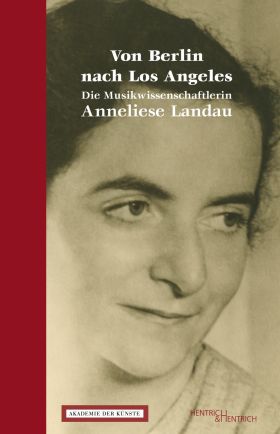
Von Berlin nach Los Angeles. Die Musikwissenschaftlerin Anneliese Landau
Daniela Reinhold on behalf of the Akademie der Künste, Berlin (ed.)
Akademie der Künste / Hentrich & Hentrich, Berlin, 2017
German, 340 pp., 15 ill.
ISBN 978-3-95565-226-5
Best.-Nr. 3044
€ 27,90
As a young musicologist, Anneliese Landau (1903–1991) was at the beginning of a promising career. In 1933, she was left with only the activities for the Jewish cultural association. In 1940, she emigrated to the United States and soon found a new home in Los Angeles, where she worked as the Music Director of the Jewish Center Association. Her autobiography, together with extracts from letters from her parents who remained in Berlin as well as Landau’s correspondence with composers, have now been published for the first time.
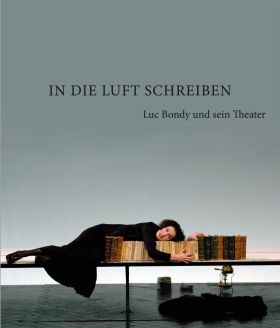
In die Luft schreiben
Luc Bondy und sein Theater
Geoffrey Layton on behalf of the Akademie der Künste (ed.)
Akademie der Künste / Alexander Verlag Berlin, Berlin, 2017
German, 320 pp., 300 ill.
ISBN 978-3-89581-451-8
Best.-Nr. 5048
€ 35
In November 2015, the director, artistic director and writer Luc Bondy died in Paris at the age of 67. This book explores the wealth and variety of his work – his international theatre career, reflected by his companions, as well as the introspective thoughts of a writer and the creative chaos that resulted from his stage productions.

Journal der Künste 4
Special Edition:
Die Mitglieder
(The Members of the Akademie der Künste)
Published four times a year,
available free of charge
ISSN 2510-5221
German
To order the print form: info@adk.de

Benjamin und Brecht.
Denken in Extremen
[Thinking in Extremes]
Erdmut Wizisla on behalf of the Akademie der Künste (ed.)
Akademie der Künste / Suhrkamp, Berlin 2017
German, 284 pp., 122 ill.
ISBN 978-3-518-42083-6
Best.-Nr. 4032
€ 32
Communication between the well-known Svendborg chess partners recalls the royal game: It employed tiring tactics, surprise attacks, retreat, strategic partnership, checkmate – and a new game. The essays and artistic commentary in the book turn the spotlight on an extraordinary constellation, in which Benjamin and Brecht appear as contemporaries in a century of extremes. They developed models for art, for politics, thought processes and for life itself; sometimes "extreme on a trial basis" and sometimes playful. With texts by Minou Arjomand, Broomberg & Chanarin, Zoe Beloff, Durs Grünbein, Barbara Hahn, Alexander Kluge, Mark Lammert, Bernd-Peter Lange, Burkhardt Lindner, Thomas Martin, Ursula Marx, Frank-M. Raddatz, Jan Philipp Reemtsma, Kristin Schulz, Marcus Steinweg, Steffen Thiemann, B. K. Tragelehn, Edmund de Waal and Erdmut Wizisla.
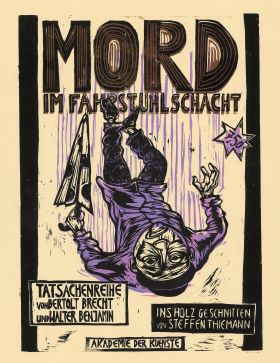
Mord im Fahrstuhlschacht
Tatsachenreihe by Bertolt Brecht and Walter Benjamin
Woodcuts by Steffen Thiemann
Graphic Novel
Akademie der Künste, Berlin 2017
German, 36 pp., 33 ill.
ISBN 978-3-88331-223-1
Best.-Nr. 4033
€ 7,50
Benjamin and Brecht decided to write a crime novel in autumn 1933. Steffen Thiemann has turned Brecht’s plot into woodcuts and set down Benjamin’s ideas as footnotes. It’s a story about blackmail that ends fatally. With texts by Steffen Thiemann and Erdmut Wizisla.
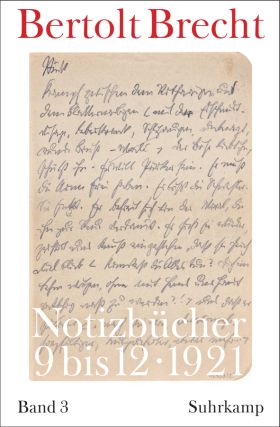
Bertolt Brecht, Notizbücher, Band 3: 1921
Martin Kölbel and Peter Villwock on behalf of the Akademie der Künste (eds.)
Akademie der Künste / Suhrkamp, Berlin 2017
German, 706 pp., 268 ill.
ISBN 978-3-518-42596-1
€ 58
Volume 3 of this notebook edition faithfully publishes four notebooks from 1921 for the first time. The focus is on Brecht’s third major work for the theatre, Im Dickicht (In the Jungle). In addition, numerous unknown drafts, notes about readings and private debates can also be found. The editors expand on Brecht’s entries in detailed text commentaries, while providing new knowledge about his work and biography.
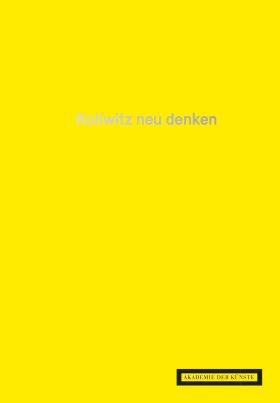
Kollwitz neu denken. Käthe-Kollwitz-Preisträger der Akademie der Künste, Berlin
Akademie der Künste, Berlin, and Käthe Kollwitz Museum Köln (eds.)
Akademie der Künste, Berlin 2017
German, 96 pp., 48 ill.
ISBN 978-3-88331-225-5
Best.-Nr. 1180
€ 14
The Akademie der Künste has been awarding the Käthe Kollwitz Prize since 1960, and it is one of its oldest distinctions. In this anniversary year, “Kollwitz 150”, the artist’s assertion, “I want to exert influence in these times when people are so at a loss and in need of help”, still sends out a clear impulse for contemporary art production. This is the focus of the exhibition at the Käthe Kollwitz Museum in Cologne.

GDR Posters
Calendar 2018
Akademie der Künste / KV&H Verlag, Weingarten, 2017
Wall calendar
Best.-Nr. 1179
€ 16,99
The controlled economy of the GDR advertised a straightforward range of products in surprising, ingenious and effective ways. Twelve colourful motifs from the Akademie der Künste’s poster collection offer insights into the wonderful, funny and effective world of GDR advertising from the 1950s. With short texts by Matthias Biskupek.

Journal der Künste 3
Published four times a year,
available free of charge
ISSN 2510-5221
German
Katja Lange-Müller opens the third edition of the Journal der Künste with thoughts on literature and writing, followed by Jutta Brückner’s commitment to work against "unconscious bias". With essays by Nikita Dhawan, and from the Akademie archives, the Akademie’s upcoming main focus – on the subject of colonialism – is being prepared. Christina Kubisch contributes an artistic analysis of silence, while Annett Busch and Tobias Hering lead tours in the exhibition on Danièle Huillet and Jean-Marie Straub. Jeanine Meerapfel talks with Rainer Esser, CEO of ZEIT Verlagsgruppe, and so much more.
To order the print form: info@adk.de
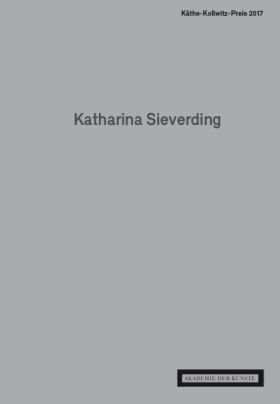
Katharina Sieverding
Käthe-Kollwitz-Preis 2017
Akademie der Künste, Berlin 2017,
German/English
48 pp., 13 ill.
ISBN 978-3-88331-221-7
Best.-Nr. 9032
€ 10
By presenting this award to Katharina Sieverding the Akademie der Künste is honouring a German artist, who was a pioneer in an age of large-scale photo art in the 1960s. The jury, made up of the Akademie members Jochen Gerz, Karin Sander and Klaus Staeck, places particular emphasis on the fact that Katharina Sieverding poses fundamental questions about artistic, political and social conditions with regard to production processes and the reception of art. A catalogue is accompanying the exhibition (beginning 12 July) of the prizewinner of the Käthe-Kollwitz-Preis, including a text by art critic and curator Hans-Jürgen Hafner.

Journal der Künste 2
Published four times a year,
available free of charge
ISSN 2510-5221
German
Debuting at the start of 2017, the new Journal der Künste will continue to be published four times a year. The free magazine provides information in German about the Akademie der Künste’s main events, publishes cultural-political contributions, introduces planned projects, and shows newly discovered objects from the archives. It is the Akademie's artistic and cultural-political thinking space. Edition 2/17 includes essays by Chantal Mouffe, Emin Alper, Gerhard Pfennig, Kathrin Röggla, Mark Lammert, et al.
To order the print form: info@adk.de
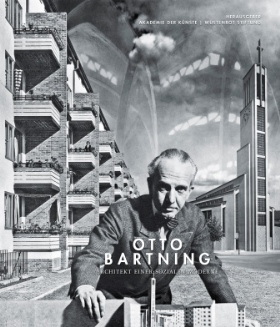
Werner Durth, Wolfgang Pehnt, Sandra Wagner-Conzelmann
Otto Bartning. Architekt einer sozialen Moderne
Akademie der Künste and Wüstenrot Stiftung (eds.)
Justus von Liebig Verlag, Darmstadt 2017
German, 128 pp., 270 ill.
ISBN 978-3-87390-393-7
out of print
This richly illustrated book to accompany the exhibition presents for the first time the main sketches, designs, models and projects from the oeuvre of an architect who, above all, is globally recognised as a seminal figure in Protestant church architecture. It documents the phases and diversity of his development from his first buildings in Imperial Germany to visions and projects as expressionism gave way to Neue Sachlichkeit in the Weimar Republic and his commitment to a postwar modernism which, through an imaginative yet restrained approach, significantly influenced the architecture of postwar Germany.

PRESENT PEOPLE.
Öffentlicher Raum entsteht erst im Gebrauch
Felix Lüdicke, Theresa Schütz on behalf of the Akademie der Künste (eds.)
Akademie der Künste, Berlin 2017
German, 80 pp., 122 ill.
ISBN 978-3-88331-222-4
Best.-Nr. 2070
€ 9,90
The architecture fellows Felix Lüdicke and Theresa Schütz created a temporary action and meeting place in the Berlin Hansaviertel with their intervention in public space. They included artists, residents, and passers-by. The publication documents their artistic work in the context of the 2015 Junge Akademie programme, which was also a contribution to the exhibition "Demo:Polis – The Right to Public Space" (2016). Essays by Michael Bräuer, Nele Hertling, Christian Schneegass, et al.

GABRIELE MÜNTER PREIS 2017
Frauenmuseum, Bonn (ed.) in
co-operation with the Akademie der Künste, Berlin
Frauenmuseum, Bonn 2017
German, 144 pp., 106 ill.
ISBN 978-3-946430032
Best.-Nr. 1178
€ 18
The prize is only open to women visual artists over the age of 40. The exhibition catalogue not only includes work by the prize winner Beate Passow but also by 19 other selected women artists: Franca Bartholomäi, Tremezza von Brentano, Nezaket Ekici, Mane Hellenthal, Margareta Hesse, Verena Kyselka, Ute Lindner, Anja Luithle, Alice Musiol, Eva von PlatenHallermund, Sibylle Prange, Vera Röhm, Christine Rusche, Heike Ruschmeyer, Corinna Schnitt, Uta Schotten, Rose Stach, Melanie Wiora, Uta Zaumseil.
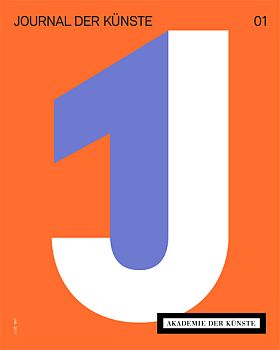
Journal der Künste 1
Published four times a year, available free of charge ISSN 2510-5221 German
The Journal der Künste looks at what is currently being created at the Akademie der Künste. It shows how diverse the aesthetic perspectives, approaches and forms of production are, both from the Archives of the Akademie and from its Sections, at the level of the Akademie members and in dialogue with our guests and visitors. An extensive editorial section features essays and lectures, along with artistic interventions, commentaries and debates on cultural policy. In regular columns such as "News from the Archives", "Finds" and "Carte Blanche" for members of the Akademie, we take a broader look beyond public programme work.